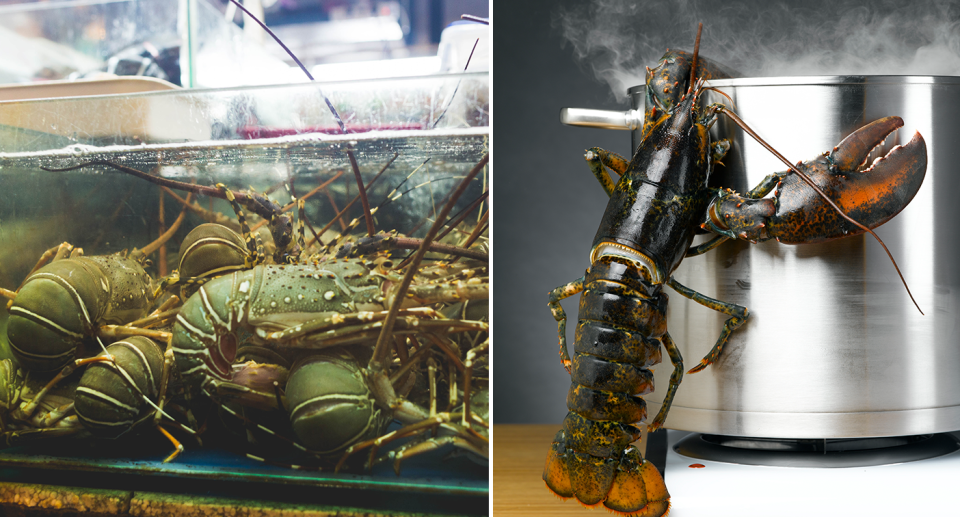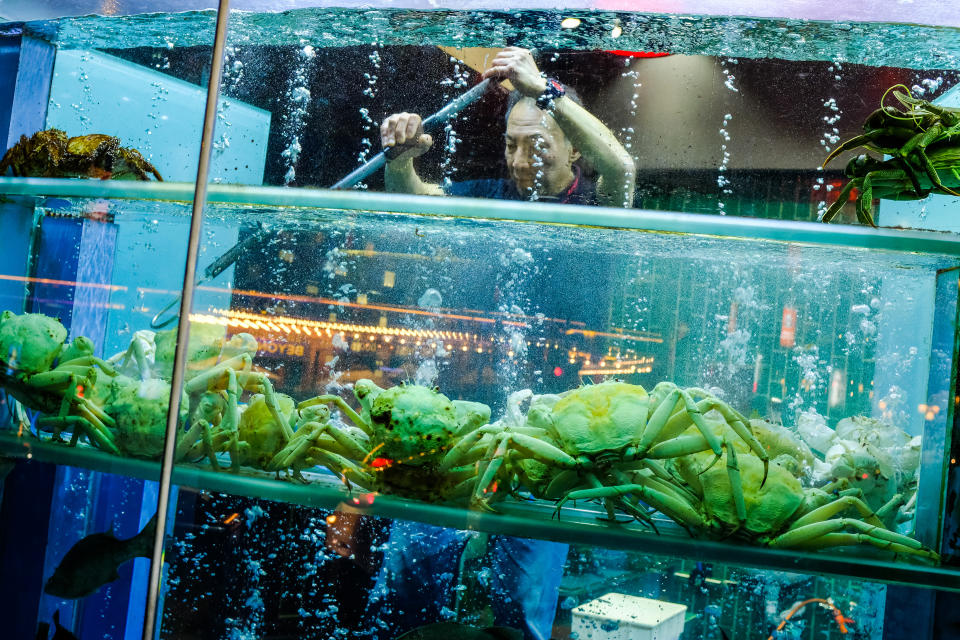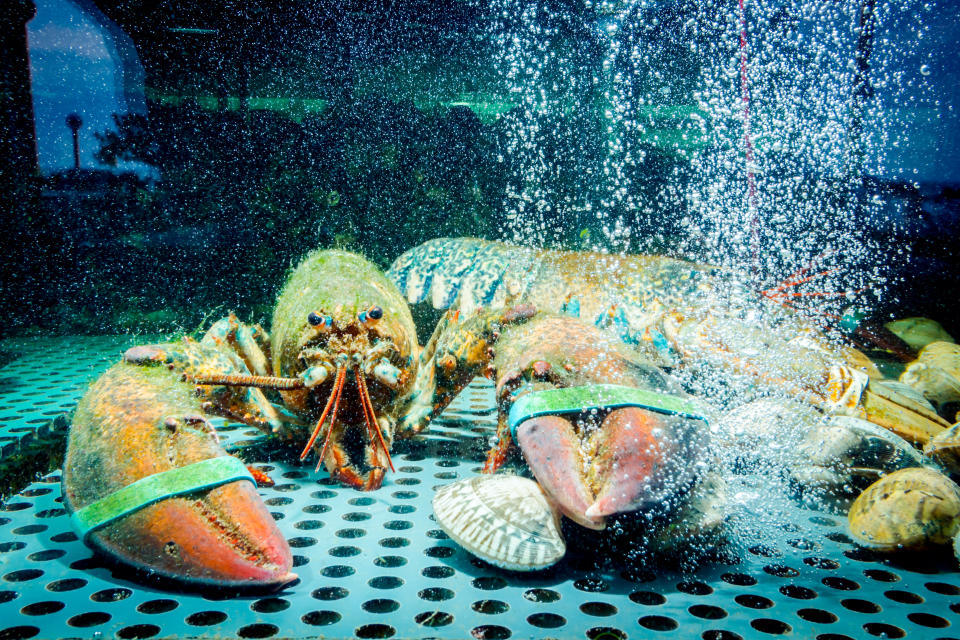'Give them a good death': Debate rages over live lobster cooking
The ethics of boiling lobsters and crabs while they’re conscious is being fiercely debated after the national body representing UK vets called on the practice to be outlawed.
Crustaceans show signs of distress and pain according to the British Veterinary Association (BVA) in a revised animal slaughter policy released in August, and that’s a position supported locally by the RSPCA.
Cooking the animals without stunning is banned in a number of countries including New Zealand and Switzerland, however, in Australia, the legislation varies in each state or territory.

In NSW, Victoria, ACT and the Northern Territory retailers must ensure they don’t treat crustaceans in a way that unreasonably, unnecessarily or unsuitably inflicts pain, and they are covered by animal protection laws.
Legislation introduced to protect lobsters within commercial settings in NSW was used to prosecute Nicholas Seafood, based at Sydney Fish Markets, after RSPCA collected video of them butchering lobsters without rendering them unconscious.
Across Australia, the RSPCA advocate for stunning to ensure immediate “loss of sensibility” before death and believe crustacea should be “captured, handled, transported, stored and killed humanely”.
‘We want to give them a good death’: Lobsters show signs of pain
While the squealing sound lobsters make when boiling alive has been found to be nothing more than gas bubbles escaping from their shells, that doesn’t mean they’re still not experiencing discomfort, according to BVA Senior Vice President Simon Doherty.
“It's very easy to get drawn into anthropomorphic discussions around does it feel pain,” Mr Doherty told Yahoo News Australia from Northern Ireland.
“Clearly animals at that strata do not necessarily feel pain in the same way as us, and they don't necessarily perceive it in the same way as us, they don’t have as intelligent a brain as we do.”
While some argue that crustacea are just reacting to the sensation of pain in a mechanical way, Mr Doherty argues behavioural research indicates they are most likely sentient.
An example of an unconscious response, he says, would be someone with a severe spinal injury, who didn’t feel pain in their feet, reacting to a pin prick without actually feeling it.

“That’s very much a reflex response,” he said.
“Where you start getting into the piece around sentience is where some of that avoidance behaviour then then becomes learned, and the animals start to learn to avoid particular situations.”
Mr Doherty backs the BVA’s position by pointing to research conducted by Queen’s University Belfast, which found crustacea that undergo unpleasant experiences learn to avoid that stimuli based on past encounters.
Further awareness of lobster welfare, Mr Doherty argues, now must be translated into practice, a process that has been implemented with chickens, pigs, cows and other livestock.

In years gone by, researchers dismissed the idea higher animals could feel pain, but now that thinking has changed and their sentience is becoming widely accepted.
Advancement in human knowledge has led to improved understanding of other species which has resulted in better animal husbandry.
“If we're making advances and throughout the entire production system, then it's only right that we should be considering that sort of last moment,” Mr Doherty said.
“If we've given them a good life, then as far as possible, we want to give them a good death.”
Lobsters ‘less advanced’ than insects
Despite a growing list of Australian industry bodies adopting practices to minimise crustacea stress, not all researchers are convinced that lobsters feel pain.
While he welcomes consumers thinking about animal welfare, Professor Caleb Gardner, a fisheries scientist at UTAS, says evidence points to these crustacea reacting to the sensation as a reflex only.

“They do not feel pain, they’re just not an advanced an animal,” he said.
“I think it’s quite a good thing to still be empathetic towards animals…I still respect people who would like to treat anything in a caring way.”
Lobster welfare, Prof Gardner believes, receives more attention than that of insects and spiders, simply because they are larger animals, despite them being less advanced than their distant cousins.
Similarly, he believes that people respond empathetically towards crabs because they have “hands”, while prawns and shrimps receive less attention because they scuttle rather than walk.

“So if we're concerned about lobsters and crabs, then we should be equally concerned if we swat a mosquito, or use fly spray one a housefly,” he said.
“I think most people are comfortable swatting a mosquito, and there’s good reason for that, because all of these arthropods have actually got very simple nervous systems.
“So, I’m not so concerned about (crustacea pain) personally.”
No easy way to kill lobsters and crabs
Peak representative body, Seafood Industry Australia (SIA), told Yahoo News Australia the humane treatment of animals is of “utmost importance”.
SIA CEO Veronica Papacosta told Yahoo News Australia the industry endeavours to “follow any best-practice animal welfare guidelines”.
“To avoid undue stress, we recommend all seafood, including crustaceans, be humanely killed before cooking,” Ms Papacosta said in a statement.
“As an industry, we advise all seafood should be killed as quickly as possible, by the most humane means suitable for each species.”

For lobsters, “current best-practice” involves chilling them for 20 to 60 minutes until they are “stunned or insensible” before they are killed via boiling or receive a spike to the back of the head.
Prof Gardner says killing crustaceans is “quite hard”, but boiling them, despite growing opposition to the practice, is actually one of the fastest methods of destruction, especially for the home chef.
While ice baths can slow some species of crustacea down, others are tolerant of cold as they are used to surviving in chilly ocean temperatures, and being frozen alive is not a particularly fast way to be put to sleep.
Using a machine to deliver an electric shock to stun crustacea is gaining traction amongst chefs at some high-end restaurants, but it is not an option available domestically.
Prof Gardner warns home cooks who try to using the “spiking method” and pierce the head more often than not end up hitting the bladder instead which is located between the eyes.
Even when done accurately, there’s another reason that spiking lobsters in the brain doesn’t work, according to the scientist.

“There's not a lot of right options for crustaceans unfortunately, and one of the reasons is they don't have a simple clear brain,” Prof Gardner said.
“All the guidelines for killing poultry or killing livestock humanely generally involves doing something to the brain, so you’ve got one target.
“You don't have that option in a lobster where there's 12 little brains if you like down its body.”
You wouldn’t boil a rabbit alive
Advocating for the humane treatment of lobsters and other decapods most vocally is UK animal welfare organisation Crustacean Compassion, which does not have an equivalent in Australia.
The group’s co-founder, Maisie Tomlinson, spoke to Yahoo News Australia from her London home, saying research has shown that it can take a brown edible crab up to three minutes to die when boiled in a pot, and death could be even slower for lobsters as they are larger.
Great Barrier Reef and more Aussie destinations 'under threat'
'My heart bleeds': Mum fights to save koalas as mine expansion looms
'Something’s going to give': Platypus staring down the barrel of extinction
'Survival instinct': Islanders scoop up oil with hands amid disaster
'World needs more of this': Dogs destined for slaughter in love with rescuers
“Now, clearly, that is absolutely unacceptable for any animal,” she said.
“We would not accept that in a vertebrate animal like rabbits, or a rat, or a mouse, in fact under EU law, the requirement is that animals should lose consciousness within one second.
“So for them to remain conscious for three minutes… is just completely unacceptable.”

Ms Tomlinson believes that electrical stunning can result in death within a second, and this not only improves animal welfare, but it improves the taste of the meat.
“Part of the reason that people like to use machines is actually because it improves the quality,” she said.
“What the manufacturers claim and indeed, what some of the chef's claim is that the meat is is more tender, it has better texture, and it has a sweeter flavour because the animals haven't been struggling.”
Ms Tomlinson said she hopes the BVA’s statement on sentience in crustacea will be the first step in giving them legal protection both in the UK and across the globe.
“No animal is more evolved or less evolved than another,” she said.
“Each animal is evolved perfectly for its specific ecological niche.
“We should be protecting all animals that are capable of experiencing pain.”
The Australian Veterinary Association did not respond to requests for comment by Yahoo News Australia.




